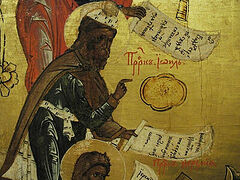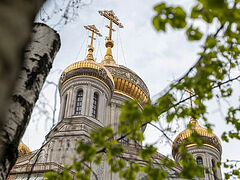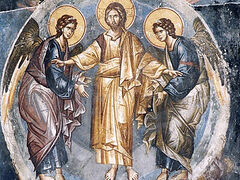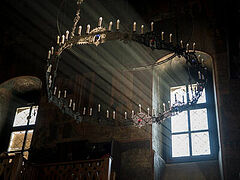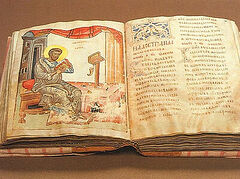We continue our talks on the book of Acts with Sergei Komarov, a well-known catechist based in Moscow.
Friends, we continue our talks on the book of the Acts of the Holy Apostles. Today we’ll be looking at chapter three, including the first miracle worked by the Apostles. It’s a very important topic. There are many miracles in the book of Acts on every page. Remember, Christ said: He that believeth on Me, the works that I do shall he do also; and greater works than these shall he do (Jn. 14:12). And now we see from the book of Acts that the Apostles truly worked miracles by the power of Christ. They worked a huge number of miracles, mostly healings. There is, for example, the resurrection of Tabitha by St. Peter, and St. Paul resurrects the young man who fell from a window during a service.
Now we’ll read about how these miracles were performed, stopping to consider some very important details.
3:1 Now Peter and John went up together into the Temple at the hour of prayer, being the ninth hour, that is three in the afternoon.
3:2 And a certain man lame from his mother’s womb… As I understand it, being crippled from your mother’s womb is something that can’t be healed, especially not in those days. Whom they laid daily at the gate of the Temple which is called Beautiful. What kind of gate it was, scholars can’t say for sure now. Basically, the Temple had many gates. Some are known today, and some are presumed. Presumably this gate led to the courtyard of the Gentiles, where both Jews and Gentiles could be. The Apostles preached there. …To ask alms of them that entered into the Temple.
3:3 Who seeing Peter and John about to go into the Temple asked an alms.
3:4 And Peter, fastening his eyes upon him with John, said, Look on us.
3:5 And he gave heed unto them, expecting to receive something of them.
This is an interesting point. What does “fastening his eyes upon him” mean? Apparently they saw faith in him, some kind of readiness for a miracle, some kind of love for God. We can only assume what they saw in him.
The Greek language is very flexible. There are four verbs here about looking and seeing. Seeing Peter and John… The word “seeing” is “idon” in Greek. Fastening his eyes upon him—this “fastening his eyes” is “nisas”—another word. They told him: Look on us—“vlepson”—a third word. And he gave heed unto them—“epikhen.” Four different words. It’s a very flexible language.
The communication between the Apostles and this lame man had some kind of non-verbal character. They looked at each other, and it was a dialogue with their eyes. It’s a very interesting point.
3:6 Then Peter said, Silver and gold have I none; but such as I have give I thee: In the name of Jesus Christ of Nazareth rise up and walk. What do you think, why did he use this formula for the name of Christ: Jesus Christ of Nazareth? Why did he say it this way? Probably because that’s what everyone called Christ.
Rise up and walk. Does this remind you of anything? Indeed, these are the words Christ spoke when healing the paralytic. Note that Christ healed by His own power. He never said: “In the name of My Father, rise and walk,” or in the name of someone else. He simply said: Rise up and walk. And in this case, St. Peter says: In the name of Jesus Christ of Nazareth rise up and walk.
And then:
3:7 And he took him by the right hand, and lifted him up. Christ also did the same thing. Whom did He take by the hand? St. Peter’s mother-in-law. The Apostles’ miracles in the name of Jesus Christ correspond to the miracles of Christ. And he took him by the right hand—the right hand is a symbol of power in the Bible. And immediately his feet and ankle bones received strength—immediately! This is a great miracle.
3:8 And he leaping up stood, and walked, and entered with them into the Temple, walking, and leaping, and praising God.
By the way, this is also very reminiscent of something. Who does the Paschal Canon say “leapt and danced?” Yes, like David “leaping and dancing” at the Ark. When they returned the Ark of the Covenant to Jerusalem, David danced. And he was half-naked. His wife later said to him: “You’re the king, why are you dancing like that?” He told her: “You don’t understand me.” She really didn’t understand. The wife didn’t understand her holy husband. It’s just like in life.
Are there miracles today? There are—many. There was even a two-volume book, Orthodox Miracles in the Twentieth Century, that describes a great many miracles of our times. Did you know we have a special Synodal department for researching signs and wonders? When something starts to stream myrrh, or something else, then experts come and investigate whether this miracle corresponds to Orthodox Tradition, whether it’s really a miracle from God. If you were to ask this commission, I think they’d have a ton of stories they could tell.
You have to be careful with miracles. The life of St. Basil of Kineshma tells about how two of his spiritual daughters came up to him and said: “Vladyka, our lampada lights itself at night while we’re praying.” At first the one woman was praying alone and saw how the lampada lit itself;she invited her friend, also an Orthodox believer, and they both prayed together and saw this wonder. And they were so joyful: “God has sent a sign to comfort us!” And he looked at them and said: “The lampada won’t light itself anymore, and I’m excommunicating you for a year for your credulity.” And the lampada didn’t light itself anymore.
Clearly it was a temptation from the enemy, aimed at making these women shift from a real spiritual life to something external. So the Orthodox attitude to miracles in general is rather restrained. And many saints have said: “I don’t need any miracles, please. I just want to be saved.” St. Gregory the Theologian said: “The greatest miracle in my life is when man turns to Christianity.” This is true. In general, it’s nearly impossible for an adult to change themselves. It’s even more impossible to change someone else. When a man comes to the Church and over the years you see that he is changing, from angry to meek, from depraved to temperate, from absent-minded to collected, then this is the most important miracle. Indeed, this is the miracle of miracles.
When people change, when they begin to love God, they begin to fight for their salvation, it means that Christ has come into their lives, and that they let Him in. As Fr. Andrei Tkachev says: “Christ is the great cardiologist. He continues to change the human heart.” It’s true.
So, that’s the Apostles’ first miracle.
3:9 And all the people saw him walking and praising God:
3:10 And they knew that it was he which sat for alms at the Beautiful gate of the Temple: and they were filled with wonder and amazement at that which had happened unto him.
Since Sts. Peter and John are missionaries, they use this miracle to preach. This is very important. The Apostles, like Christ, took advantage of any moment to say something, and especially when some miracle was performed.
Sts. John and Peter work a miracle in order to deliver a sermon. They help this man not only physically, but also spiritually. God pities man. God can help a man simply, without even requiring faith from him. Recall the raising of the son of the widow of Nain. Christ didn’t preach anything there. It just says the dead man was raised up, and that’s it. But this is also a sermon—it’s a miracle. And here’s an important thought: Sometimes Christ works miracles just because He pities a man. You can find a mystical meaning there, but first of all, God simply pitied the poor suffering woman. It’s very good, very touching.
3:11 And as the lame man which was healed held Peter and John, all the people ran together unto them in the porch that is called Solomon's, greatly wondering.
3:12 And when Peter saw it, he answered unto the people, Ye men of Israel…
This is the beginning of St. Peter’s second sermon. It’s quite different from his first sermon. It’s more daring. He almost doesn’t refer to the prophets anymore, but refers to himself, to the Apostles. He says: “We are witnesses that Christ is Risen” (cf. 3:15), and he speaks very boldly about Christ.
If you read the homilies of the ancient Holy Fathers on these verses, you see that the Fathers understand sickness and healing from sickness, as described in the Gospels, allegorically. Physical sickness indicates some spiritual sickness. The sick whom Christ or the Apostles heal in the New Testament function as symbols.
For example, the paralyzed are images of mankind, which lies in spiritual paralysis, helplessness, and no one can help it but Christ. Or, for example, the blind man. Who is blind? I am blind, seeing the sins of others but not my own. It’s this kind of spiritual blindness. Who is lame? He who goes not to do God’s good deeds, but to sin. Who has a withered hand? The hand is a symbol of activity in the Bible. A man with a withered hand is one who is spiritually exhausted, who can no longer do good deeds or please God due to his condition. Who is a leper? Leprosy was an incurable disease in those times. This is man’s incurable sinfulness. Again, only Christ can heal him. Who is deaf? He who doesn’t hear the word of God.
There’s the concept of circumcision in Sacred Scripture. Interestingly, according to Scripture, not only the sex organs can be circumcised or uncircumcised, but also the heart and ears—in the spiritual sense. People with uncircumcised ears are those who have no sensitivity to hear God. God tells them something but they only hear themselves.
Thus, it’s all about us. The sick in the New Testament are an image of the spiritual states in which we find ourselves at one time or another in our lives. Therefore, we have to read it all spiritually.
I want you to note how the Apostles looked at this lame man. Remember, there was some kind of interesting dialogue with their eyes. They looked at him, and he at them… Then St. Peter preaches:
3:16 And His name through faith in His name hath made this man strong, whom ye see and know: yea, the faith which is by Him hath given him this perfect soundness in the presence of you all.
That is, it turns out this man had some kind of faith in Christ. The miracles of the New Testament are synergistic. Sometimes Christ works miracles without asking faith from the man. For example, there’s the paralytic who was brought by his four friends. It doesn’t say whether he had faith, but his friends had faith. In most cases, Christ either requires faith or it’s somehow implied. In this case, the healing of this lame man had a synergistic character. On the one hand, it’s the action of God, and on the other, it’s the cooperation of God and man.
Remember, the Gospel says that Christ was unable to heal too many in Nazareth because of their unbelief (Mt. 13:58). It doesn’t mean He didn’t have the power to heal them. He’s God—He’s omnipotent. But there’s a certain law of cooperation between God and man. There can be no religious or spiritual violence against a man here if he doesn’t want to be healed, if he doesn’t believe in God. God can heal him, but it will either do him harm or negatively affect him somehow. That’s why it says that Christ “couldn’t.” It sounds absurd, doesn’t it? Christ can do anything. But Christ did not many mighty works there because of their unbelief. Faith was necessary for this healing—it's necessary for man, not for God.
This faith is something mysterious, that connects us with God, that makes miracles possible in principle. There won’t be any miracles if you don’t believe. On the other hand, the Apostle Paul writes: … a sign, not to them that believe, but to them that believe not (1 Cor. 14:22). There are miracles for the unbelievers—for their admonition. But to work a miracle or not—it’s God Who decides. There’s nothing mechanical here.
If we’re talking about miracles, then our faith and the Christian life is a miracle. The spiritual-moral change of a man according to the image of God is a miracle. And such miracles don’t happen without faith.
It’s important that miracles happen in the name of Jesus Christ. When we see “in the name of” in Sacred Scripture, it means the name of God, as a rule. When it says that something happens in the name of the Lord God, it means that God is acting by His power at that moment—through His holy name.
The paganism of that time had the concept of working a miracle in the name of some “god.” If a man knew the name of some “god” and performed a magic ritual, it meant not only was he cooperating with this “god,” but that he could also control him, that he had some kind of power over him. It’s a magical mindset. It’s not in vainthat Moses asked the name of God at the Burning Bush, and God cryptically answered: “I will be Whom I will be,” or, I AM THAT I AM (Ex. 3:14), that is, “I am the way I am, and you won’t understand anyways.” There’s no word for “God” in human language that could encapsulate the whole of God.
Or, for instance, when Jacob asks God His name while struggling with Him, God answers: “My name is wonderful.”[1] He seems to shy away from pronouncing His name. In the episode with the Burning Bush, the phrase that God says to Moses: “I will be Whom I will be,” can also be read in the present tense: “I am Who I am.” Here you can see a cryptic reference to Christ. God as if says to Moses: “You believe Me, you follow Me, and I will reveal to you in the future that I will be Whom I will be.” And God reveals Himself to man as never before—in the name of Jesus (the Savior).
The sacred Tetragrammaton is inscribed in this name. If we take the Hebrew letters of the name Yehoshua (Jesus), there are the first three letters: yod, he, and waw. These are the first three letters of the Tetragrammaton, which is transcribed in the Old Testament as Jehovah, or Yahweh (the latter is more correct); that is, the name of Christ means “Yahweh saves.”
The righteous do miracles not from themselves, but by the name of God. God acts through them, and the name is the presence of God. In the name of God is the energy of God, the activity of God. There was a heresy in the beginning of the twentieth century on Mt. Athos, in the Russian St. Panteleimon’s Monastery, and not just there: the heresy of Name-worshiping. In the name of God—“Jesus”—the ascetics saw the presence of God as such. And they believed you could replace all prayers, even the Liturgy, with this name. There’s a book by Vladyka Hilarion (Alfeyev), The Holy Mystery of the Church, about Name-worshiping, if anyone wants to read it. Expressing the consensus of the Fathers of the Eastern Church, Vladyka notes the following points on this topic:
- “The name of God is not identical or co-eternal with God. It’s not an integral part of the Divine essence. There was a time when God had no name, and there will again be a time when He has no name. The name of God is a means of communication between God and man.
- “God is unnamed. There is no name that can embrace and adequately express the Divine essence. All the names of God indicate certain properties of God, but none of them can give a complete and comprehensive idea of God.
- “The names of God are derived from various actions of God in relation to the created world, and therefore are properly the names of the energies of God. The energies of God are co-eternal with God and are inseparable from the Divine essence. The names of God, on the other hand, are not co-eternal with God.
- “The names of God exist for man, and in human language. Even when God Himself calls Himself by this or that name, He’s using names that exist in human language.
- “Each of the names of God has its outer shell (letters and sounds) and its inner content. The outer shell can change depending on the language, context, or way of pronouncing and writing, but the inner content remains unchanged.
- “God is present in each of His names. His presence is felt by man when he pronounces the name of God with faith and reverence, but it remains imperceptible when the name of God is spoken in vain.
- “Every name of God is worthy of veneration, along with other sacred symbols, such as an icon or cross. It’s not the outer shell of the name that’s venerated, but its inner content. In venerating the name of God, man gives glory to God: Honor given to the image passes on to the Prototype.
- “There is no power of its own autonomously or magically acting in the name of God. God Himself acts through the names of God.
- “In prayer, the name of God is inseparable from God Himself.
- “The name ‘Jesus’ refers to the human nature of the Incarnate Word, but may also indicate His Divine nature. Like every name of God, it is worthy of veneration.”
That is, God Himself is present in the name of God, but we can’t say that the name of God is God Himself. Don’t think that the name of God is an energy of God. Rather, God acts in the name of God; the energy of God is present in the name of God. The name of God is worthy of veneration, but on the condition that it’s not the outer shell of the name that’s being venerated, but the bearer of the name; that is, God. The power of God acts through the name of God, but the name is powerful not in its outer shell, but by the power of God, acting through the name.
When the Apostle heals in the name of Christ, it doesn’t mean he possesses the power of Christ. Christ acts through him. God is present in His name when we say the name of God with faith. We believe that by His energies, His grace, His glory, God is invisibly present in His name and helps us when we make the Sign of the Cross and call upon the name of Christ.
Therefore, when it says in the name of Jesus, it means that St. Peter considers Christ to be God, because miracles aren’t performed in the name of man—only in and through the name of God.








